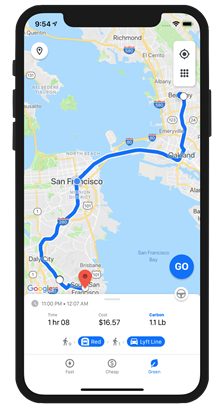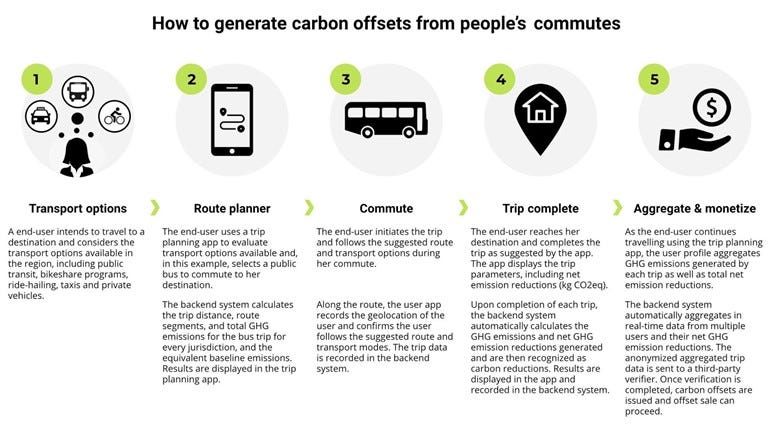
How carbon markets can (and will) accelerate the decarbonization of the transportation sector
Climate change poses one of the greatest risks to the survival of the human species. A landmark report by the UN Intergovernmental Panel on Climate Change (IPCC) released in 2018 warned that there are only about a dozen years for global warming to be kept to a maximum of 1.5°C.
With growing concerns about the pressing environmental problems caused by the transportation sector, reducing the adverse environmental impact of urban mobility is emerging as a great challenge. It is important to enabling consumers to identify the environmental impact associated with their transport choices and let them make informed decisions about how to make their commutes more sustainable.
The transportation industry is undergoing a profound transformation, driven by a need to reduce its carbon footprint. Worldwide, 16.2% of global emissions come from transportation, an increase of 70% over 1990’s levels. In cities, transportation represents 40% of total emissions, far outpacing any other source.

A first-hand experience with carbon offsets in the public transit
Before joining UITP, as part of my role at Delhi Integrated Multi-Modal Transit System Limited (DIMTS), I experienced first-hand the challenges posed by the existing carbon programs and GHG quantification methodologies. At DIMTS, I worked to register the Delhi Bus Rapid Transit (BRT) project under UNFCC to generate carbon credits under the CDM program. Unfortunately, the project did not qualify under that program. The Delhi government introduced new low-floor CNG buses on the corridor in place of standard-floor CNG buses, which resulted in higher per passenger emission. Finally, the project failed to certify under the CDM program.
UITP has led discussions to address climate change at multiple national and international forums, and partners with a multitude of key agencies including the United Nations, to promote the use of public transport in cities. In September 2019, UITP launched the new campaign #ONEPLANet with its members, along with a Climate Action Manifesto which detailed a four-step action plan to reduce transport emissions in cities.
Many new and existing solutions help reduce the environmental impact of transportation, but based on the graphs above, more needs to be done.
However, one of the biggest challenges to achieve widespread deployment of new low-carbon technologies and solutions is their (usually) higher cost. But what if these new technologies could be financed not through public funds but other non-public funding mechanisms? It turns out, the energy sector figured it out more than 20 years ago.
Carbon markets, both regulated and voluntary, have existed for decades. The utility sector has long leveraged them to decarbonize its industry. The Paris Agreement — Article 6 validated carbon markets as an essential tool to meet its reduction goals. Why is the transport sector not leveraging capital available in carbon markets to accelerate its decarbonization? Despite some early successful projects, such as the BRT Transmilenio in Bogota, Colombia, the transportation sector has failed to make offsets projects widespread across the world.

Until recently, there has been no simple yet effective way to develop offset projects in the transportation sector. However, in 2018, Greenlines Technology launched Cowlines, a free trip planning app across North America. Thanks to its patent-pending carbon engine, the app automatically quantifies carbon emissions generated by each user trip, determines a baseline, and calculates the resulting carbon reductions, aggregating them with thousands of other trips. In 2019, Greenlines completed the first-ever sale of mobility offsets produced by app users commuting with hundreds of public transit agencies, ride-hailing companies, bike and scooter sharing programs, and more. Greenlines is now in discussions with several large mobility players to integrate its carbon engine into their own platforms.

Quantifying and monetizing carbon reductions is a game-changer for the transportation sector: it enables end-users to understand their carbon footprint and incentivizes them to use low-carbon options. For mobility companies and public transit agencies, it incentivizes them to invest in low-carbon modes of transport to generate large offset revenues.
Last September, Mark Carney, former governor of the Bank of Canada and Bank of England, announced the launch of a global task force to accelerate the development of voluntary carbon markets with top figures from business, finance, and academia. Carney warned, “in order to meet the growing demand for offsets, current private-sector carbon markets would need to grow by at least 15-fold on today’s levels, potentially reaching up to 160 times bigger”.
Clearly, carbon markets can — and will — play a key role in the decarbonization of industry sectors. There is no reason for the transportation sector not to jump on board. Now, the tools are finally here.
“It always seems impossible until it’s done.” — Nelson Mandela
Originally published on Medium
